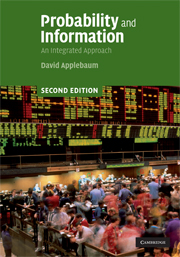Book contents
- Frontmatter
- Contents
- Preface to the second edition
- Preface to the first edition
- 1 Introduction
- 2 Combinatorics
- 3 Sets and measures
- 4 Probability
- 5 Discrete random variables
- 6 Information and entropy
- 7 Communication
- 8 Random variables with probability density functions
- 9 Random vectors
- 10 Markov chains and their entropy
- Exploring further
- Appendix 1 Proof by mathematical induction
- Appendix 2 Lagrange multipliers
- Appendix 3 Integration of exp(−½x2)
- Appendix 4 Table of probabilities associated with the standard normal distribution
- Appendix 5 A rapid review of matrix algebra
- Selected solutions
- Index
Preface to the first edition
Published online by Cambridge University Press: 06 July 2010
- Frontmatter
- Contents
- Preface to the second edition
- Preface to the first edition
- 1 Introduction
- 2 Combinatorics
- 3 Sets and measures
- 4 Probability
- 5 Discrete random variables
- 6 Information and entropy
- 7 Communication
- 8 Random variables with probability density functions
- 9 Random vectors
- 10 Markov chains and their entropy
- Exploring further
- Appendix 1 Proof by mathematical induction
- Appendix 2 Lagrange multipliers
- Appendix 3 Integration of exp(−½x2)
- Appendix 4 Table of probabilities associated with the standard normal distribution
- Appendix 5 A rapid review of matrix algebra
- Selected solutions
- Index
Summary
This is designed to be an introductory text for a modern course on the fundamentals of probability and information. It has been written to address the needs of undergraduate mathematics students in the ‘new’ universities and much of it is based on courses developed for the Mathematical Methods for Information Technology degree at the Nottingham Trent University. Bearing in mind that such students do not often have a firm background in traditional mathematics, I have attempted to keep the development of material gently paced and user friendly – at least in the first few chapters. I hope that such an approach will also be of value to mathematics students in ‘old’ universities, as well as students on courses other than honours mathematics who need to understand probabilistic ideas.
I have tried to address in this volume a number of problems which I perceive in the traditional teaching of these subjects. Many students first meet probability theory as part of an introductory course in statistics. As such, they often encounter the subject as a ragbag of different techniques without the same systematic development that they might gain in a course in, say, group theory. Later on, they might have the opportunity to remedy this by taking a final-year course in rigorous measure theoretic probability, but this, if it exists at all, is likely to be an option only. Consequently, many students can graduate with degrees in mathematical sciences, but without a coherent understanding of the mathematics of probability.
- Type
- Chapter
- Information
- Probability and InformationAn Integrated Approach, pp. xiii - xviPublisher: Cambridge University PressPrint publication year: 2008



